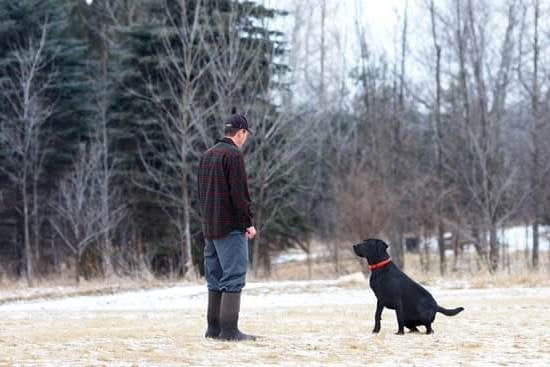Can dogs be trained to smell viruses? The idea might seem far-fetched, but recent studies and anecdotal evidence suggest that dogs possess an incredible ability to detect diseases, including viruses, through their sense of smell. In this article, we will explore the potential of using dogs as virus detectors, examining the science behind their sense of smell, successful case studies, potential benefits, training methods, challenges and limitations, ethical considerations, and the future possibilities in this fascinating field.
Dogs have long been used for their keen sense of smell in various fields such as search and rescue, drug detection, and bomb sniffing. However, recent research has shown that they may also have the ability to detect viruses such as cancer cells or even COVID-19. By understanding the science behind a dog’s sense of smell and how it relates to virus detection, we can potentially harness this natural ability to improve our current diagnostic methods.
This article will delve into case studies where trained dogs have successfully detected viruses in controlled settings. We will also explore the potential benefits of using dogs as virus detectors in various settings such as airports, hospitals, and public spaces.
Furthermore, we will examine the different methods used to train dogs for virus detection and discuss the challenges and limitations associated with using dogs for this purpose. Stay tuned as we uncover the exciting potential for dogs to revolutionize virus detection.
The Science Behind a Dog’s Sense of Smell and How It Relates to Virus Detection
Dogs have an incredible sense of smell, which is estimated to be tens of thousands to hundreds of thousands times more sensitive than humans. This is due to the large number of olfactory receptors in their noses, as well as the size and structure of their brains’ olfactory bulbs. These physiological characteristics enable dogs to detect scents at incredibly low concentrations, making them ideal candidates for detecting various substances, including viruses.
The science behind a dog’s sense of smell and its relation to virus detection lies in their ability to detect volatile organic compounds (VOCs) that are emitted by viruses. When a person is infected with a virus, the body’s immune response triggers metabolic changes that lead to the release of specific VOCs. Dogs can be trained to identify these unique odors, allowing them to effectively distinguish between infected and uninfected individuals.
To train dogs in virus detection, several methods can be employed:
- Positive reinforcement: This method involves rewarding the dog when it correctly identifies the target scent, reinforcing the behavior through treats or play.
- Operant conditioning: Dogs can be trained using operant conditioning techniques such as clicker training, where they learn to associate the target scent with a positive outcome.
- Scent recognition training: By gradually introducing and familiarizing the dog with the target scent, they learn to recognize and differentiate it from other scents.
Additionally, ongoing research explores molecular profiling techniques to identify specific VOCs associated with different viruses, aiding in the development of more accurate training protocols for virus detection dogs. As this research progresses, it holds promising implications for enhancing the effectiveness and reliability of dogs as virus detectors.
Case Studies of Successful Virus Detection by Trained Dogs
Dogs have been successfully trained to detect various diseases and viruses in humans, demonstrating that they can be an effective tool in virus detection. In recent years, there have been several case studies highlighting the remarkable ability of dogs to sniff out viruses with a high degree of accuracy.
Covid-19
During the COVID-19 pandemic, researchers conducted a study in which dogs were trained to detect the virus by scent. The results were promising, with the dogs showing an impressive ability to identify individuals infected with COVID-19. This research suggests that dogs could potentially be used as a screening tool in airports, hospitals, and other public settings to help identify carriers of the virus.
Other Viruses
In addition to COVID-19, dogs have also been trained to detect other viruses such as malaria, cancer, and bacterial infections. One notable example is the successful use of dogs to identify individuals infected with malaria by smelling samples of their clothing. This showcases the potential for using dogs as a non-invasive and cost-effective method for virus detection in various parts of the world where traditional testing methods may be limited.
Previous Successes
Furthermore, there have been previous successes in training dogs to detect viruses such as influenza and SARS. These case studies provide compelling evidence for the capability of dogs to accurately identify individuals infected with different types of viruses, indicating that their sense of smell can be harnessed for early detection and containment efforts.
These case studies demonstrate the potential for using dogs as an additional resource in virus detection efforts, complementing existing diagnostic methods and providing an effective means of early identification. As research in this area continues to advance, it is clear that trained dogs hold great promise in revolutionizing virus detection across various healthcare and public health settings.
The Potential Benefits of Using Dogs as Virus Detectors in Various Settings
Dogs have been known to have an incredible sense of smell, and this has led to the exploration of their potential in detecting viruses. The use of dogs as virus detectors in various settings holds numerous benefits.
One of the key advantages is their ability to screen a large number of people quickly and efficiently, especially in high-traffic areas such as airports, hospitals, and public events. This could potentially help in early detection and prevention of the spread of contagious viruses.
In addition, using dogs as virus detectors can be a non-invasive method that avoids the need for invasive procedures such as blood tests or nasal swabs. This can be particularly advantageous in situations where individuals may be reluctant or unable to undergo traditional testing methods. Furthermore, dogs are able to detect viruses at an early stage, potentially leading to earlier treatment and containment measures.
Another benefit is the cost-effectiveness of using dogs for virus detection. Training and maintaining a team of trained virus detection dogs may prove to be more affordable than other traditional diagnostic methods. This can make virus detection more accessible, especially in resource-limited areas where access to laboratory facilities and medical equipment may be limited. Overall, the potential benefits of using dogs as virus detectors in various settings make them a promising tool in the fight against contagious diseases.
Different Methods of Training Dogs to Detect Viruses
Training dogs to detect viruses involves utilizing their exceptional sense of smell, a skill that has been honed for thousands of years. One of the most common methods used is known as “scent detection training”, where dogs are taught to recognize the specific odor associated with a particular virus. This method typically involves using samples of the virus in question and pairing it with a reward for the dog when they successfully identify the scent.
Another method used in training dogs to detect viruses is through “odor imprinting”, where a young puppy is exposed to the scent of the virus during a critical period of their development. This exposure helps them form strong associations with that particular smell, making it easier for them to identify it later on. The success of this method depends on the age at which the puppy is exposed to the scent, as well as the length and frequency of exposure.
A third method is called “operant conditioning”, in which dogs are trained to perform specific actions, such as sitting or barking, in response to detecting the presence of a virus. This method involves positive reinforcement, rewarding the dog for displaying the desired behavior when they encounter the target odor.
It’s important to note that while these methods have proven successful in training dogs to detect viruses, they require time, effort, and expertise from skilled trainers. Additionally, ongoing research is being conducted to explore new and more efficient methods for training dogs in virus detection.
| Methods | Description |
|---|---|
| Scent Detection Training | Dogs are taught to recognize specific odors associated with viruses. |
| Odor Imprinting | Youthful exposure helps puppies form associations with viral scents. |
| Operant Conditioning | Dogs are trained to perform specific actions upon detecting viruses. |
Challenges and Limitations of Using Dogs as Virus Detectors
Dogs have shown incredible potential in detecting viruses, but there are also challenges and limitations to consider when using them as virus detectors. One challenge is the need for rigorous, ongoing training to ensure that the dogs maintain their accuracy in detecting viruses.
This requires a significant investment of time and resources, as well as a team of skilled handlers and trainers. Additionally, dogs may experience sensory fatigue or distractions in real-world environments, which can affect their ability to accurately detect viruses.
Another limitation is the variability in individual dog performance. Not all dogs may have the same level of sensitivity or reliability in virus detection, so it’s important to carefully select and assess potential detection dogs based on their aptitude and health. Furthermore, environmental factors such as weather conditions or background odors can also impact a dog’s ability to effectively detect viruses. These variables must be taken into account when using dogs as virus detectors in different settings.
Despite these challenges and limitations, the benefits of using dogs as virus detectors cannot be overlooked. Research has shown that when properly trained and maintained, sniffer dogs can achieve remarkable success rates in virus detection.
Their ability to rapidly screen large groups of people or samples for the presence of viruses makes them valuable allies in public health crises such as pandemics. Continued research and innovation will be essential in addressing these challenges and maximizing the potential of dogs as virus detectors.
| Challenges | Limitations |
|---|---|
| The need for rigorous ongoing training | Variable individual dog performance |
| Sensory fatigue and distractions | Environmental factors impact on detection |
Ethical Considerations in Using Dogs for Virus Detection
When considering the use of dogs for virus detection, it is crucial to address the ethical implications of such a practice. While the potential benefits of using dogs as virus detectors are significant, there are several ethical considerations that must be taken into account.
First and foremost, it is essential to ensure that the dogs involved in virus detection training are treated with the utmost care and respect. This includes providing them with proper training, ensuring their physical and mental well-being, and allowing them to lead a fulfilling life outside of their work as virus detectors.
Additionally, there is an ethical responsibility to consider the consent of both the dogs and the individuals whose samples they are trained to detect. It is important to establish clear guidelines for how these samples are obtained, used, and stored to ensure that privacy and autonomy are respected at all times.
Furthermore, there may also be concerns about exploiting dogs for human benefit, especially if their involvement in virus detection places them at risk or causes them undue stress. It is crucial to carefully monitor the welfare of these animals and make adjustments to their training or working conditions as needed.
In summary, while there is great potential for using dogs as virus detectors, it is imperative to approach this practice with great thoughtfulness and consideration for the well-being of the dogs involved and the ethical implications for all parties.
Future Possibilities and the Ongoing Research in Dog Virus Detection Training
The potential for dogs to revolutionize virus detection is exciting and holds great promise for the future. With the ongoing research in dog virus detection training, there are numerous possibilities that could greatly impact public health and safety. One such possibility is the development of specialized detection dogs that can identify specific viruses, such as COVID-19, with a high degree of accuracy. This would allow for rapid and reliable screening of individuals in various settings.
Researchers are continuing to explore the potential of using dogs to detect viruses through their sense of smell. Ongoing studies are investigating the efficacy of trained virus detection dogs in real-world scenarios, such as at airports or healthcare facilities.
Additionally, ongoing research is focused on identifying the specific volatile organic compounds (VOCs) associated with different viruses, which can aid in the training of virus detection dogs. This research is crucial in understanding how to best utilize dogs as virus detectors and maximizing their effectiveness in various environments.
The ongoing research in dog virus detection training also has the potential to have a significant impact on public health efforts worldwide. The use of trained virus detection dogs could provide an additional layer of protection against the spread of infectious diseases, especially those with asymptomatic carriers. Additionally, this research could lead to advancements in early detection and containment strategies for outbreaks, ultimately saving lives and preventing widespread transmission of viruses.
As researchers continue to delve into this field, it is important to recognize that further exploration and investment into dog virus detection training is necessary to fully realize its potential benefits and overcome any challenges or limitations.
Conclusion
In conclusion, the potential for dogs to revolutionize virus detection is a promising and exciting area of research that has shown significant success in various case studies. The science behind a dog’s sense of smell and its ability to detect viruses has provided compelling evidence for the effectiveness of using dogs as virus detectors.
The benefits of using trained dogs in various settings, such as airports, hospitals, and public spaces, are numerous, including their quick and non-invasive detection abilities.
Despite the challenges and limitations associated with using dogs as virus detectors, ongoing research and advancements in training methods continue to improve the reliability and accuracy of this approach. Ethical considerations have also been addressed through proper care and treatment of the dogs involved in virus detection training programs, ensuring their well-being is prioritized.
The need for further exploration in this area is evident as it holds great potential to enhance current virus detection methods. As new viruses continue to emerge and existing ones evolve, the role of trained dogs in virus detection could prove to be invaluable. Continued research and collaboration between scientists, veterinarians, and dog trainers will be essential in tapping into this unique capability of dogs and maximizing its practical applications in public health and disease control.
Frequently Asked Questions
Can Dogs Smell Out Diseases?
Yes, dogs have an incredible sense of smell that allows them to detect diseases in humans. Research has shown that dogs can be trained to detect various diseases such as cancer, malaria, and diabetes by sniffing specific odor molecules present in a person’s breath, urine, or sweat.
How Do They Train Dogs to Sniff Out COVID-19?
Dogs are trained to sniff out COVID-19 through a process called odor imprinting. This involves exposing the dog to saliva and urine samples from COVID-19 patients so they may familiarize themselves with the scent of the virus. Once the dog recognizes the scent, they are trained to indicate a positive sample by sitting, lying down, or barking.
Are Dogs Trained to Sniff Out COVID in Schools Getting a Lot of Love for Their Efforts?
Yes, dogs trained to sniff out COVID-19 in schools are indeed receiving a lot of love for their efforts. These specially trained dogs play a crucial role in helping to keep school environments safe by identifying potential COVID-19 cases quickly and efficiently.
Their ability to detect the virus early on contributes significantly to preventing its spread within school communities and the wider population.

Welcome to the blog! I am a professional dog trainer and have been working with dogs for many years. In this blog, I will be discussing various topics related to dog training, including tips, tricks, and advice. I hope you find this information helpful and informative. Thanks for reading!





